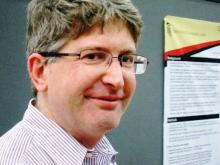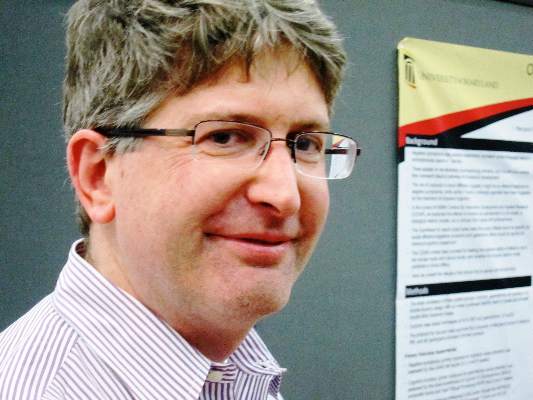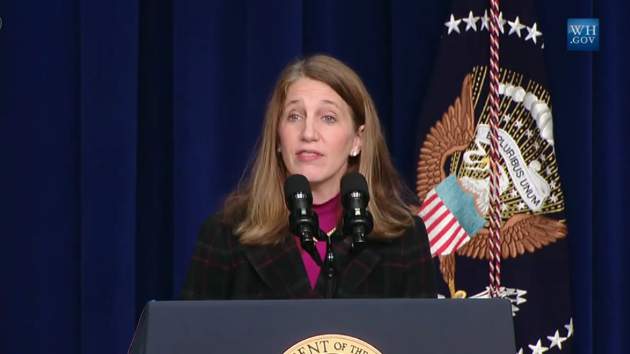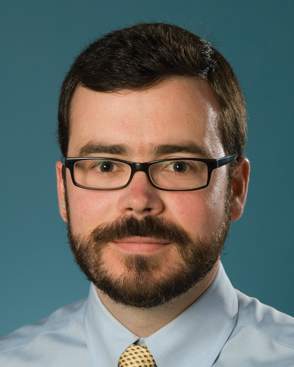User login
Three-month injectable paliperidone palmitate delayed relapse in schizophrenia up to 1 year
COLORADO SPRINGS– Three-month injectable paliperidone palmitate significantly delayed time to relapse compared to placebo in patients with schizophrenia, according to phase III clinical study data being presented at the biennial meeting of the 15th International Congress on Schizophrenia Research.
The study also was published in JAMA Psychiatry.
If approved, patients would be dosed with only four injections of the atypical antipsychotic per year rather than once per month, which is the current dosing for the injectable formulation. Oral atypical antipsychotics are administered daily.
“It would be nice if there were more use, in general, of the long-acting injectables, and we hope these data will encourage that because it would increase [compliance],” Dr. Adam Savitz, a researcher on the study, said in an interview. “If it gets approved, it’s something clinicians should consider their patients could benefit from.”
Janssen, maker of the drug, has filed a New Drug Application with the Food and Drug Administration for the 3-month paliperidone palmitate injection to treat schizophrenia in adults. According to a statement from the company, a regulatory action is expected on May 18, 2015, after which time Janssen plans to file for markets outside the United States.
The multicenter, international trial conducted from April 26, 2012, through April 9, 2014, included 506 adults randomized to either the study drug or to placebo. Conducted in four phases, the study began with a 3-week screening phase, followed by a flexible-dose 17-week open-label transition phase in which patients received once-monthly doses of the 1-month formulation of paliperidone palmitate (50, 75, 100, or 150 mg). During the 12-week open-label maintenance phase, patients received a single dose of the 3-month formulation at 3.5 times the stabilized dose of their once-monthly formulation dose (JAMA Psychiatry 2015; March 29 [doi.10.1001/jamapsychiatry.2015.024]).
During the final, double-blind phase, 160 stabilized patients were randomized to 3-month paliperidone palmitate (175, 263, 350, or 525 mg), once every 3 months, and 145 stabilized patients similarly received placebo.
In an interim analysis, the time from randomization to relapse significantly favored paliperidone palmitate vs. placebo (hazard ratio, 3.45; 95% confidence interval, 1.73-6.88; P < .001). The median time before relapse was 274 days for placebo but, according to Dr. Savitz, was not estimable for the study arm.
“The interim analysis more was than 270 days after randomization, so if you think about it, that’s a very long time, because even those who were switched to placebo continued to have protection from relapse after having one dose. In the final analysis, it was actually a year-long protection, after people stopped getting the medication,” Dr. Savitz said in the interview.
This primary analysis of the data, also presented this week at the 23rd annual European Congress of Psychiatry in Vienna, is based on the interim results of time to first relapse, which were strong enough to have provoked an early termination for the study.
Treatment-emergent adverse events recorded during the double blind phase occurred in 62% of the 3-month paliperidone palmitate group and in 58% of the placebo group. Headache and weight gain were the most common (9% vs. 4% and 9% vs. 3%), respectively, followed by nasopharyngitis (6% vs. 1%), and akathisia (4% vs. 1%).
Dr. Savitz recommended that if the drug is approved, “It’s important to remember that the person has to be stabilized first using the 1-month dose,” and that it not be used in people who are allergic to risperidone or who have other allergies.
Dr. Savitz is the director of clinical research, neuroscience, and psychiatry at Janssen Pharmaceuticals.
On Twitter @whitneymcknight
COLORADO SPRINGS– Three-month injectable paliperidone palmitate significantly delayed time to relapse compared to placebo in patients with schizophrenia, according to phase III clinical study data being presented at the biennial meeting of the 15th International Congress on Schizophrenia Research.
The study also was published in JAMA Psychiatry.
If approved, patients would be dosed with only four injections of the atypical antipsychotic per year rather than once per month, which is the current dosing for the injectable formulation. Oral atypical antipsychotics are administered daily.
“It would be nice if there were more use, in general, of the long-acting injectables, and we hope these data will encourage that because it would increase [compliance],” Dr. Adam Savitz, a researcher on the study, said in an interview. “If it gets approved, it’s something clinicians should consider their patients could benefit from.”
Janssen, maker of the drug, has filed a New Drug Application with the Food and Drug Administration for the 3-month paliperidone palmitate injection to treat schizophrenia in adults. According to a statement from the company, a regulatory action is expected on May 18, 2015, after which time Janssen plans to file for markets outside the United States.
The multicenter, international trial conducted from April 26, 2012, through April 9, 2014, included 506 adults randomized to either the study drug or to placebo. Conducted in four phases, the study began with a 3-week screening phase, followed by a flexible-dose 17-week open-label transition phase in which patients received once-monthly doses of the 1-month formulation of paliperidone palmitate (50, 75, 100, or 150 mg). During the 12-week open-label maintenance phase, patients received a single dose of the 3-month formulation at 3.5 times the stabilized dose of their once-monthly formulation dose (JAMA Psychiatry 2015; March 29 [doi.10.1001/jamapsychiatry.2015.024]).
During the final, double-blind phase, 160 stabilized patients were randomized to 3-month paliperidone palmitate (175, 263, 350, or 525 mg), once every 3 months, and 145 stabilized patients similarly received placebo.
In an interim analysis, the time from randomization to relapse significantly favored paliperidone palmitate vs. placebo (hazard ratio, 3.45; 95% confidence interval, 1.73-6.88; P < .001). The median time before relapse was 274 days for placebo but, according to Dr. Savitz, was not estimable for the study arm.
“The interim analysis more was than 270 days after randomization, so if you think about it, that’s a very long time, because even those who were switched to placebo continued to have protection from relapse after having one dose. In the final analysis, it was actually a year-long protection, after people stopped getting the medication,” Dr. Savitz said in the interview.
This primary analysis of the data, also presented this week at the 23rd annual European Congress of Psychiatry in Vienna, is based on the interim results of time to first relapse, which were strong enough to have provoked an early termination for the study.
Treatment-emergent adverse events recorded during the double blind phase occurred in 62% of the 3-month paliperidone palmitate group and in 58% of the placebo group. Headache and weight gain were the most common (9% vs. 4% and 9% vs. 3%), respectively, followed by nasopharyngitis (6% vs. 1%), and akathisia (4% vs. 1%).
Dr. Savitz recommended that if the drug is approved, “It’s important to remember that the person has to be stabilized first using the 1-month dose,” and that it not be used in people who are allergic to risperidone or who have other allergies.
Dr. Savitz is the director of clinical research, neuroscience, and psychiatry at Janssen Pharmaceuticals.
On Twitter @whitneymcknight
COLORADO SPRINGS– Three-month injectable paliperidone palmitate significantly delayed time to relapse compared to placebo in patients with schizophrenia, according to phase III clinical study data being presented at the biennial meeting of the 15th International Congress on Schizophrenia Research.
The study also was published in JAMA Psychiatry.
If approved, patients would be dosed with only four injections of the atypical antipsychotic per year rather than once per month, which is the current dosing for the injectable formulation. Oral atypical antipsychotics are administered daily.
“It would be nice if there were more use, in general, of the long-acting injectables, and we hope these data will encourage that because it would increase [compliance],” Dr. Adam Savitz, a researcher on the study, said in an interview. “If it gets approved, it’s something clinicians should consider their patients could benefit from.”
Janssen, maker of the drug, has filed a New Drug Application with the Food and Drug Administration for the 3-month paliperidone palmitate injection to treat schizophrenia in adults. According to a statement from the company, a regulatory action is expected on May 18, 2015, after which time Janssen plans to file for markets outside the United States.
The multicenter, international trial conducted from April 26, 2012, through April 9, 2014, included 506 adults randomized to either the study drug or to placebo. Conducted in four phases, the study began with a 3-week screening phase, followed by a flexible-dose 17-week open-label transition phase in which patients received once-monthly doses of the 1-month formulation of paliperidone palmitate (50, 75, 100, or 150 mg). During the 12-week open-label maintenance phase, patients received a single dose of the 3-month formulation at 3.5 times the stabilized dose of their once-monthly formulation dose (JAMA Psychiatry 2015; March 29 [doi.10.1001/jamapsychiatry.2015.024]).
During the final, double-blind phase, 160 stabilized patients were randomized to 3-month paliperidone palmitate (175, 263, 350, or 525 mg), once every 3 months, and 145 stabilized patients similarly received placebo.
In an interim analysis, the time from randomization to relapse significantly favored paliperidone palmitate vs. placebo (hazard ratio, 3.45; 95% confidence interval, 1.73-6.88; P < .001). The median time before relapse was 274 days for placebo but, according to Dr. Savitz, was not estimable for the study arm.
“The interim analysis more was than 270 days after randomization, so if you think about it, that’s a very long time, because even those who were switched to placebo continued to have protection from relapse after having one dose. In the final analysis, it was actually a year-long protection, after people stopped getting the medication,” Dr. Savitz said in the interview.
This primary analysis of the data, also presented this week at the 23rd annual European Congress of Psychiatry in Vienna, is based on the interim results of time to first relapse, which were strong enough to have provoked an early termination for the study.
Treatment-emergent adverse events recorded during the double blind phase occurred in 62% of the 3-month paliperidone palmitate group and in 58% of the placebo group. Headache and weight gain were the most common (9% vs. 4% and 9% vs. 3%), respectively, followed by nasopharyngitis (6% vs. 1%), and akathisia (4% vs. 1%).
Dr. Savitz recommended that if the drug is approved, “It’s important to remember that the person has to be stabilized first using the 1-month dose,” and that it not be used in people who are allergic to risperidone or who have other allergies.
Dr. Savitz is the director of clinical research, neuroscience, and psychiatry at Janssen Pharmaceuticals.
On Twitter @whitneymcknight
AT THE INTERNATIONAL CONGRESS ON SCHIZOPHRENIA RESEARCH
Key clinical point: Injectable atypical antipsychotic dosed at 3 months could improve compliance.
Major finding: Compared with placebo, 3-month formulation of paliperidone palmitate administered 4 times yearly significantly delayed time to relapse in patients with schizophrenia.
Data source: Phase III, multisite, international, 2-year randomly controlled, double-blind study of 506 adult patients with schizophrenia.
Disclosures: Dr. Savitz is the director of clinical research, neuroscience, and psychiatry at Janssen Pharmaceuticals.
VIDEO: PDT Tops Blue-light Therapy for Actinic Keratosis
KAUAI, HAWAII – Using photodynamic therapy in place of blue-light therapy to reverse sun damage such as actinic keratosis is less expensive and associated with fewer adverse events such as pain, according to Dr. Christopher Zachary.
Dr. Zachary, chair of dermatology at the University of California, Irvine, shared his perspectives in a video on the advantages of photodynamic therapy over other field treatments, particularly in an era of changing health care reimbursements.
He spoke at the Hawaii Dermatology Seminar sponsored by Global Academy for Medical Education/Skin Disease Education Foundation. SDEF and this news organization are owned by the same parent company.

KAUAI, HAWAII – Using photodynamic therapy in place of blue-light therapy to reverse sun damage such as actinic keratosis is less expensive and associated with fewer adverse events such as pain, according to Dr. Christopher Zachary.
Dr. Zachary, chair of dermatology at the University of California, Irvine, shared his perspectives in a video on the advantages of photodynamic therapy over other field treatments, particularly in an era of changing health care reimbursements.
He spoke at the Hawaii Dermatology Seminar sponsored by Global Academy for Medical Education/Skin Disease Education Foundation. SDEF and this news organization are owned by the same parent company.

KAUAI, HAWAII – Using photodynamic therapy in place of blue-light therapy to reverse sun damage such as actinic keratosis is less expensive and associated with fewer adverse events such as pain, according to Dr. Christopher Zachary.
Dr. Zachary, chair of dermatology at the University of California, Irvine, shared his perspectives in a video on the advantages of photodynamic therapy over other field treatments, particularly in an era of changing health care reimbursements.
He spoke at the Hawaii Dermatology Seminar sponsored by Global Academy for Medical Education/Skin Disease Education Foundation. SDEF and this news organization are owned by the same parent company.

EXPERT ANALYSIS FROM SDEF HAWAII DERMATOLOGY SEMINAR
VIDEO: PDT tops blue-light therapy for actinic keratosis
KAUAI, HAWAII – Using photodynamic therapy in place of blue-light therapy to reverse sun damage such as actinic keratosis is less expensive and associated with fewer adverse events such as pain, according to Dr. Christopher Zachary.
Dr. Zachary, chair of dermatology at the University of California, Irvine, shared his perspectives in a video on the advantages of photodynamic therapy over other field treatments, particularly in an era of changing health care reimbursements.
He spoke at the Hawaii Dermatology Seminar sponsored by Global Academy for Medical Education/Skin Disease Education Foundation. SDEF and this news organization are owned by the same parent company.
On Twitter @whitneymcknight
KAUAI, HAWAII – Using photodynamic therapy in place of blue-light therapy to reverse sun damage such as actinic keratosis is less expensive and associated with fewer adverse events such as pain, according to Dr. Christopher Zachary.
Dr. Zachary, chair of dermatology at the University of California, Irvine, shared his perspectives in a video on the advantages of photodynamic therapy over other field treatments, particularly in an era of changing health care reimbursements.
He spoke at the Hawaii Dermatology Seminar sponsored by Global Academy for Medical Education/Skin Disease Education Foundation. SDEF and this news organization are owned by the same parent company.
On Twitter @whitneymcknight
KAUAI, HAWAII – Using photodynamic therapy in place of blue-light therapy to reverse sun damage such as actinic keratosis is less expensive and associated with fewer adverse events such as pain, according to Dr. Christopher Zachary.
Dr. Zachary, chair of dermatology at the University of California, Irvine, shared his perspectives in a video on the advantages of photodynamic therapy over other field treatments, particularly in an era of changing health care reimbursements.
He spoke at the Hawaii Dermatology Seminar sponsored by Global Academy for Medical Education/Skin Disease Education Foundation. SDEF and this news organization are owned by the same parent company.
On Twitter @whitneymcknight
EXPERT ANALYSIS FROM SDEF HAWAII DERMATOLOGY SEMINAR
Value-based medicine gets boost from launch of information-sharing network
The federal government has launched the Health Care Payment Learning and Action Network as a way to help physicians and other players in the health care system transition to value-based medical care. The network was announced March 25 at a White House event.
“Health reform is really hard,” President Obama said at the event. “Everyone in the trenches knows that.”
In January, Sylvia M. Burwell, secretary of the Department of Health & Human Services, announced what the administration portrays as the next step in heath reform. Building on the cost-saving efforts of the health reform law’s accountable care organizations, HHS plans to shift at least a third of all Medicare payments away from fee-for-service to value-based payment models by 2016. By 2018, half of all Medicare payments are to be value based.
The Health Care Payment Learning and Action Network is intended to support those goals and give everyone a say in the process’s success, Secretary Burwell said at the briefing.
Specifically, the network will facilitate new care delivery models and the collection, analysis, and leverage of data from them; break down obstacles to care; create evidence-based quality metrics that do not create record-keeping burdens; and foster transparency in the health care system, according to the Centers for Medicare & Medicaid Services.
Over 2,800 partners have registered with the network, including physician organizations, insurers, accountable care organizations, hospitals and health systems, and patient advocacy groups, according to CMS.
At the briefing, Bruce Broussard, CEO of network partner Humana, said that the ACA’s focus on quality has “wrapped the focus around the journey of someone’s health. It’s really changing the system from a treatment-oriented one to a health-oriented one.”
Dr. Robert Wah, president of the American Medical Association, said that his organization joined the network because of the access to decision makers that participation is expected to give.
“It is critical that physicians take a proactive role in defining the details of new payment models, and this network will help facilitate that,” Dr. Wah said in an interview.
On Twitter @whitneymcknight
The federal government has launched the Health Care Payment Learning and Action Network as a way to help physicians and other players in the health care system transition to value-based medical care. The network was announced March 25 at a White House event.
“Health reform is really hard,” President Obama said at the event. “Everyone in the trenches knows that.”
In January, Sylvia M. Burwell, secretary of the Department of Health & Human Services, announced what the administration portrays as the next step in heath reform. Building on the cost-saving efforts of the health reform law’s accountable care organizations, HHS plans to shift at least a third of all Medicare payments away from fee-for-service to value-based payment models by 2016. By 2018, half of all Medicare payments are to be value based.
The Health Care Payment Learning and Action Network is intended to support those goals and give everyone a say in the process’s success, Secretary Burwell said at the briefing.
Specifically, the network will facilitate new care delivery models and the collection, analysis, and leverage of data from them; break down obstacles to care; create evidence-based quality metrics that do not create record-keeping burdens; and foster transparency in the health care system, according to the Centers for Medicare & Medicaid Services.
Over 2,800 partners have registered with the network, including physician organizations, insurers, accountable care organizations, hospitals and health systems, and patient advocacy groups, according to CMS.
At the briefing, Bruce Broussard, CEO of network partner Humana, said that the ACA’s focus on quality has “wrapped the focus around the journey of someone’s health. It’s really changing the system from a treatment-oriented one to a health-oriented one.”
Dr. Robert Wah, president of the American Medical Association, said that his organization joined the network because of the access to decision makers that participation is expected to give.
“It is critical that physicians take a proactive role in defining the details of new payment models, and this network will help facilitate that,” Dr. Wah said in an interview.
On Twitter @whitneymcknight
The federal government has launched the Health Care Payment Learning and Action Network as a way to help physicians and other players in the health care system transition to value-based medical care. The network was announced March 25 at a White House event.
“Health reform is really hard,” President Obama said at the event. “Everyone in the trenches knows that.”
In January, Sylvia M. Burwell, secretary of the Department of Health & Human Services, announced what the administration portrays as the next step in heath reform. Building on the cost-saving efforts of the health reform law’s accountable care organizations, HHS plans to shift at least a third of all Medicare payments away from fee-for-service to value-based payment models by 2016. By 2018, half of all Medicare payments are to be value based.
The Health Care Payment Learning and Action Network is intended to support those goals and give everyone a say in the process’s success, Secretary Burwell said at the briefing.
Specifically, the network will facilitate new care delivery models and the collection, analysis, and leverage of data from them; break down obstacles to care; create evidence-based quality metrics that do not create record-keeping burdens; and foster transparency in the health care system, according to the Centers for Medicare & Medicaid Services.
Over 2,800 partners have registered with the network, including physician organizations, insurers, accountable care organizations, hospitals and health systems, and patient advocacy groups, according to CMS.
At the briefing, Bruce Broussard, CEO of network partner Humana, said that the ACA’s focus on quality has “wrapped the focus around the journey of someone’s health. It’s really changing the system from a treatment-oriented one to a health-oriented one.”
Dr. Robert Wah, president of the American Medical Association, said that his organization joined the network because of the access to decision makers that participation is expected to give.
“It is critical that physicians take a proactive role in defining the details of new payment models, and this network will help facilitate that,” Dr. Wah said in an interview.
On Twitter @whitneymcknight
FROM A WHITE HOUSE PRESS BRIEFING
Value-based payment: Time to start getting ready
WASHINGTON– Are physicians ready for the shift toward value-based compensation?
A report from the American Medical Association and the RAND Corporation aims to get physicians thinking about what investments they should expect to make and what obstacles they may encounter as they prepare for the federal government’s switch from fee-for-service to value-based medicine in 2018.
“There is a lot of enthusiasm for change,” Dr. Mark W. Friedberg, senior natural scientist at RAND in Boston and lead researcher on the report, said in an interview. “There is a lot of hope this will result in better patient care and physician success. It’s a matter of the details.”
The report is based on survey data from 34 practices across the country, all of which have some form of alternative payment structure in place, whether it be accountable care or bundled services. Practices were located in rural and urban settings ranging from hospital- to physician-owned or corporately managed, all with varying sizes of patient panels.
The top concern that practice managers faced was matching the appropriate alternative payment model to their particular patient population, researchers found. Other concerns included how best to use incentives without adversely affecting patient care and how to avoid physician burn-out.
These concerns, Dr. Friedberg said, point to a need for payers to offer guidance about what makes sense when and why. “We got the message that more communication between payers and physician practices tends to be a good thing.”
Many of the coming changes will require updated technology. Finding the money for such an overhaul is a universal preoccupation of many practice managers, and another reason some practices have yet to switch. “Some of the time, practices can get a loan, or have the reserves to do it on their own, but sometimes they don’t and they need to partner with a large organization like a hospital or a large physician group,” Dr. Friedberg said.
Payers are not likely to help foot the bill, according to Susan DeVore, president and chief executive officer of Premier Health, a performance improvement alliance of hospitals and other providers.
“It would be wonderful if the health plans would spend hundreds of millions of dollars for the technology enablement of the physician practices and the health systems,” Ms. DeVore said at the press conference. “The truth is, health systems and physicians are [already] spending the billions to build these technology infrastructures, and they need to do that together.”
She called for more systemwide transparent collaboration in how cost is determined and in how quality and outcomes are measured. “It’s not fair to say we need a coordinated system of care, but then we can’t do it for lots of regulatory reasons,” she said noting that ultimately, she believed such information sharing would be determined by Congress.
Payers, should, however, make sure that physicians and other providers have a seat at the table when performance metrics are determined, Dr. Friedberg said.
“Some of the concerns we heard were that, in addition to the number of measures, was also whether individual measures are clinically valid, and do they really reflect true differences in the quality of the patient care. Is it possible that the measure isn’t really reliable and not adequately risk adjusted, and therefore might not be ready for prime time in a payment contract?”
Although the report did not offer specific time frames practice managers could expect before a new structure would take hold, Ms. DeVore said she was aware of some practices that realized more than a third more profits within 3 years of switching to value-based care models.
Chet Burrell, president and CEO of CareFirst BlueCross BlueShield, said his group’s experience was that overall, physicians were not ready for the change to value-based care. This, despite the insurer’s announcement that $1 in every $5 it spends on reimbursement is now tied to quality care.
For physicians who are ready to make the shift to value-based payment, Mr. Burrell said an average of 5 years was necessary to fully integrate. “Each practice is its own ecosystem. Some physicians catch on very quickly, but some are hostile.”
On Twitter @whitneymcknight
WASHINGTON– Are physicians ready for the shift toward value-based compensation?
A report from the American Medical Association and the RAND Corporation aims to get physicians thinking about what investments they should expect to make and what obstacles they may encounter as they prepare for the federal government’s switch from fee-for-service to value-based medicine in 2018.
“There is a lot of enthusiasm for change,” Dr. Mark W. Friedberg, senior natural scientist at RAND in Boston and lead researcher on the report, said in an interview. “There is a lot of hope this will result in better patient care and physician success. It’s a matter of the details.”
The report is based on survey data from 34 practices across the country, all of which have some form of alternative payment structure in place, whether it be accountable care or bundled services. Practices were located in rural and urban settings ranging from hospital- to physician-owned or corporately managed, all with varying sizes of patient panels.
The top concern that practice managers faced was matching the appropriate alternative payment model to their particular patient population, researchers found. Other concerns included how best to use incentives without adversely affecting patient care and how to avoid physician burn-out.
These concerns, Dr. Friedberg said, point to a need for payers to offer guidance about what makes sense when and why. “We got the message that more communication between payers and physician practices tends to be a good thing.”
Many of the coming changes will require updated technology. Finding the money for such an overhaul is a universal preoccupation of many practice managers, and another reason some practices have yet to switch. “Some of the time, practices can get a loan, or have the reserves to do it on their own, but sometimes they don’t and they need to partner with a large organization like a hospital or a large physician group,” Dr. Friedberg said.
Payers are not likely to help foot the bill, according to Susan DeVore, president and chief executive officer of Premier Health, a performance improvement alliance of hospitals and other providers.
“It would be wonderful if the health plans would spend hundreds of millions of dollars for the technology enablement of the physician practices and the health systems,” Ms. DeVore said at the press conference. “The truth is, health systems and physicians are [already] spending the billions to build these technology infrastructures, and they need to do that together.”
She called for more systemwide transparent collaboration in how cost is determined and in how quality and outcomes are measured. “It’s not fair to say we need a coordinated system of care, but then we can’t do it for lots of regulatory reasons,” she said noting that ultimately, she believed such information sharing would be determined by Congress.
Payers, should, however, make sure that physicians and other providers have a seat at the table when performance metrics are determined, Dr. Friedberg said.
“Some of the concerns we heard were that, in addition to the number of measures, was also whether individual measures are clinically valid, and do they really reflect true differences in the quality of the patient care. Is it possible that the measure isn’t really reliable and not adequately risk adjusted, and therefore might not be ready for prime time in a payment contract?”
Although the report did not offer specific time frames practice managers could expect before a new structure would take hold, Ms. DeVore said she was aware of some practices that realized more than a third more profits within 3 years of switching to value-based care models.
Chet Burrell, president and CEO of CareFirst BlueCross BlueShield, said his group’s experience was that overall, physicians were not ready for the change to value-based care. This, despite the insurer’s announcement that $1 in every $5 it spends on reimbursement is now tied to quality care.
For physicians who are ready to make the shift to value-based payment, Mr. Burrell said an average of 5 years was necessary to fully integrate. “Each practice is its own ecosystem. Some physicians catch on very quickly, but some are hostile.”
On Twitter @whitneymcknight
WASHINGTON– Are physicians ready for the shift toward value-based compensation?
A report from the American Medical Association and the RAND Corporation aims to get physicians thinking about what investments they should expect to make and what obstacles they may encounter as they prepare for the federal government’s switch from fee-for-service to value-based medicine in 2018.
“There is a lot of enthusiasm for change,” Dr. Mark W. Friedberg, senior natural scientist at RAND in Boston and lead researcher on the report, said in an interview. “There is a lot of hope this will result in better patient care and physician success. It’s a matter of the details.”
The report is based on survey data from 34 practices across the country, all of which have some form of alternative payment structure in place, whether it be accountable care or bundled services. Practices were located in rural and urban settings ranging from hospital- to physician-owned or corporately managed, all with varying sizes of patient panels.
The top concern that practice managers faced was matching the appropriate alternative payment model to their particular patient population, researchers found. Other concerns included how best to use incentives without adversely affecting patient care and how to avoid physician burn-out.
These concerns, Dr. Friedberg said, point to a need for payers to offer guidance about what makes sense when and why. “We got the message that more communication between payers and physician practices tends to be a good thing.”
Many of the coming changes will require updated technology. Finding the money for such an overhaul is a universal preoccupation of many practice managers, and another reason some practices have yet to switch. “Some of the time, practices can get a loan, or have the reserves to do it on their own, but sometimes they don’t and they need to partner with a large organization like a hospital or a large physician group,” Dr. Friedberg said.
Payers are not likely to help foot the bill, according to Susan DeVore, president and chief executive officer of Premier Health, a performance improvement alliance of hospitals and other providers.
“It would be wonderful if the health plans would spend hundreds of millions of dollars for the technology enablement of the physician practices and the health systems,” Ms. DeVore said at the press conference. “The truth is, health systems and physicians are [already] spending the billions to build these technology infrastructures, and they need to do that together.”
She called for more systemwide transparent collaboration in how cost is determined and in how quality and outcomes are measured. “It’s not fair to say we need a coordinated system of care, but then we can’t do it for lots of regulatory reasons,” she said noting that ultimately, she believed such information sharing would be determined by Congress.
Payers, should, however, make sure that physicians and other providers have a seat at the table when performance metrics are determined, Dr. Friedberg said.
“Some of the concerns we heard were that, in addition to the number of measures, was also whether individual measures are clinically valid, and do they really reflect true differences in the quality of the patient care. Is it possible that the measure isn’t really reliable and not adequately risk adjusted, and therefore might not be ready for prime time in a payment contract?”
Although the report did not offer specific time frames practice managers could expect before a new structure would take hold, Ms. DeVore said she was aware of some practices that realized more than a third more profits within 3 years of switching to value-based care models.
Chet Burrell, president and CEO of CareFirst BlueCross BlueShield, said his group’s experience was that overall, physicians were not ready for the change to value-based care. This, despite the insurer’s announcement that $1 in every $5 it spends on reimbursement is now tied to quality care.
For physicians who are ready to make the shift to value-based payment, Mr. Burrell said an average of 5 years was necessary to fully integrate. “Each practice is its own ecosystem. Some physicians catch on very quickly, but some are hostile.”
On Twitter @whitneymcknight
AT AN AMA/RAND BRIEFING
VIDEO: Expert offers tips on buying, using dermatoscopes
KAUAI, HAWAII – If you’re thinking of offering dermoscopy to your patients, which are the best machines for your practice? Are there advantages to having one machine or several? And will you need to do certain kinds of biopsies instead of others?
Dr. David L. Swanson of the Mayo Clinic in Scottsdale, Ariz., was this year’s featured dermoscopy expert at the annual Hawaii Dermatology Seminar sponsored by Global Academy for Medical Education/Skin Disease Education Foundation. He shared his top tips for helping physicians maximize the latest in this technology for the benefit of your patients.
Skin Disease Education Foundation and this news organization are owned by the same parent company.
The video associated with this article is no longer available on this site. Please view all of our videos on the MDedge YouTube channel
On Twitter @whitneymcknight
KAUAI, HAWAII – If you’re thinking of offering dermoscopy to your patients, which are the best machines for your practice? Are there advantages to having one machine or several? And will you need to do certain kinds of biopsies instead of others?
Dr. David L. Swanson of the Mayo Clinic in Scottsdale, Ariz., was this year’s featured dermoscopy expert at the annual Hawaii Dermatology Seminar sponsored by Global Academy for Medical Education/Skin Disease Education Foundation. He shared his top tips for helping physicians maximize the latest in this technology for the benefit of your patients.
Skin Disease Education Foundation and this news organization are owned by the same parent company.
The video associated with this article is no longer available on this site. Please view all of our videos on the MDedge YouTube channel
On Twitter @whitneymcknight
KAUAI, HAWAII – If you’re thinking of offering dermoscopy to your patients, which are the best machines for your practice? Are there advantages to having one machine or several? And will you need to do certain kinds of biopsies instead of others?
Dr. David L. Swanson of the Mayo Clinic in Scottsdale, Ariz., was this year’s featured dermoscopy expert at the annual Hawaii Dermatology Seminar sponsored by Global Academy for Medical Education/Skin Disease Education Foundation. He shared his top tips for helping physicians maximize the latest in this technology for the benefit of your patients.
Skin Disease Education Foundation and this news organization are owned by the same parent company.
The video associated with this article is no longer available on this site. Please view all of our videos on the MDedge YouTube channel
On Twitter @whitneymcknight
EXPERT ANALYSIS FROM THE SDEF HAWAII DERMATOLOGY SEMINAR 2015
FDA Green Lights Sublingual Antipsychotic to Treat Bipolar I in Children
For the first time in 5 years, the Food and Drug Administration has approved an application to market an antipsychotic to clinicians for treating bipolar I disorder in children aged 10-17 years.
Actavis, the Dublin-based pharmaceutical manufacturer, announced March 13 that the FDA has approved the company’s supplemental new drug application for asenapine (Saphris), a second-generation atypical antipsychotic, as monotherapy for the acute treatment of manic or mixed episodes associated with bipolar I disorder in this pediatric population.
The FDA approved asenapine in 2009 for treating adults with manic or mixed episodes of bipolar I, either as monotherapy or adjunctive to either lithium or valproate. It also is indicated for the acute or maintenance treatment of schizophrenia in adults.
Asenapine is administered as a sublingual tablet, and the company announced in the statement that it would begin marketing black cherry–flavored sublingual asenapine tablets in 2.5 mg, 5 mg, and 10 mg doses beginning in the second quarter of this year.
According to the manufacturer, the agency’s approval was granted based on the results of a 3-week monotherapy trial in 403 pediatric patients, aged 10-17 years, 302 of whom were treated twice daily with either 2.5 mg, 5 mg, or 10 mg of asenapine. The drug maker also said asenapine demonstrated improvement in the Young Mania Rating Scale total score and the Clinical Global Impressions-Bipolar Scale overall score, compared with placebo.
When asked about the approval, Dr. David Fassler said it's helpful to have a range of medications to treat pediatric patients with bipolar disorder. "However, the current approval is based on results of a relatively short-term clinical trial," said Dr. Fassler, clinical professor of psychiatry at the University of Vermont, Burlington. "In the real world, many young people ultimately take atypical antipsychotics for an extended period of time. Physicians and parents need data on the safety and efficacy of these medications when used on a more long-term or ongoing basis in order to make fully informed decisions about treatment options."
The most common side effects the company said it recorded in the pediatric clinical trial were sleepiness, dizziness, strange sense of taste, numbing of the mouth, nausea, increased appetite, feeling tired, and weight gain.
For the first time in 5 years, the Food and Drug Administration has approved an application to market an antipsychotic to clinicians for treating bipolar I disorder in children aged 10-17 years.
Actavis, the Dublin-based pharmaceutical manufacturer, announced March 13 that the FDA has approved the company’s supplemental new drug application for asenapine (Saphris), a second-generation atypical antipsychotic, as monotherapy for the acute treatment of manic or mixed episodes associated with bipolar I disorder in this pediatric population.
The FDA approved asenapine in 2009 for treating adults with manic or mixed episodes of bipolar I, either as monotherapy or adjunctive to either lithium or valproate. It also is indicated for the acute or maintenance treatment of schizophrenia in adults.
Asenapine is administered as a sublingual tablet, and the company announced in the statement that it would begin marketing black cherry–flavored sublingual asenapine tablets in 2.5 mg, 5 mg, and 10 mg doses beginning in the second quarter of this year.
According to the manufacturer, the agency’s approval was granted based on the results of a 3-week monotherapy trial in 403 pediatric patients, aged 10-17 years, 302 of whom were treated twice daily with either 2.5 mg, 5 mg, or 10 mg of asenapine. The drug maker also said asenapine demonstrated improvement in the Young Mania Rating Scale total score and the Clinical Global Impressions-Bipolar Scale overall score, compared with placebo.
When asked about the approval, Dr. David Fassler said it's helpful to have a range of medications to treat pediatric patients with bipolar disorder. "However, the current approval is based on results of a relatively short-term clinical trial," said Dr. Fassler, clinical professor of psychiatry at the University of Vermont, Burlington. "In the real world, many young people ultimately take atypical antipsychotics for an extended period of time. Physicians and parents need data on the safety and efficacy of these medications when used on a more long-term or ongoing basis in order to make fully informed decisions about treatment options."
The most common side effects the company said it recorded in the pediatric clinical trial were sleepiness, dizziness, strange sense of taste, numbing of the mouth, nausea, increased appetite, feeling tired, and weight gain.
For the first time in 5 years, the Food and Drug Administration has approved an application to market an antipsychotic to clinicians for treating bipolar I disorder in children aged 10-17 years.
Actavis, the Dublin-based pharmaceutical manufacturer, announced March 13 that the FDA has approved the company’s supplemental new drug application for asenapine (Saphris), a second-generation atypical antipsychotic, as monotherapy for the acute treatment of manic or mixed episodes associated with bipolar I disorder in this pediatric population.
The FDA approved asenapine in 2009 for treating adults with manic or mixed episodes of bipolar I, either as monotherapy or adjunctive to either lithium or valproate. It also is indicated for the acute or maintenance treatment of schizophrenia in adults.
Asenapine is administered as a sublingual tablet, and the company announced in the statement that it would begin marketing black cherry–flavored sublingual asenapine tablets in 2.5 mg, 5 mg, and 10 mg doses beginning in the second quarter of this year.
According to the manufacturer, the agency’s approval was granted based on the results of a 3-week monotherapy trial in 403 pediatric patients, aged 10-17 years, 302 of whom were treated twice daily with either 2.5 mg, 5 mg, or 10 mg of asenapine. The drug maker also said asenapine demonstrated improvement in the Young Mania Rating Scale total score and the Clinical Global Impressions-Bipolar Scale overall score, compared with placebo.
When asked about the approval, Dr. David Fassler said it's helpful to have a range of medications to treat pediatric patients with bipolar disorder. "However, the current approval is based on results of a relatively short-term clinical trial," said Dr. Fassler, clinical professor of psychiatry at the University of Vermont, Burlington. "In the real world, many young people ultimately take atypical antipsychotics for an extended period of time. Physicians and parents need data on the safety and efficacy of these medications when used on a more long-term or ongoing basis in order to make fully informed decisions about treatment options."
The most common side effects the company said it recorded in the pediatric clinical trial were sleepiness, dizziness, strange sense of taste, numbing of the mouth, nausea, increased appetite, feeling tired, and weight gain.
FDA green lights sublingual antipsychotic to treat bipolar I in children
For the first time in 5 years, the Food and Drug Administration has approved an application to market an antipsychotic to clinicians for treating bipolar I disorder in children aged 10-17 years.
Actavis, the Dublin-based pharmaceutical manufacturer, announced March 13 that the FDA has approved the company’s supplemental new drug application for asenapine (Saphris), a second-generation atypical antipsychotic, as monotherapy for the acute treatment of manic or mixed episodes associated with bipolar I disorder in this pediatric population.
The FDA approved asenapine in 2009 for treating adults with manic or mixed episodes of bipolar I, either as monotherapy or adjunctive to either lithium or valproate. It also is indicated for the acute or maintenance treatment of schizophrenia in adults.
Asenapine is administered as a sublingual tablet, and the company announced in the statement that it would begin marketing black cherry–flavored sublingual asenapine tablets in 2.5 mg, 5 mg, and 10 mg doses beginning in the second quarter of this year.
According to the manufacturer, the agency’s approval was granted based on the results of a 3-week monotherapy trial in 403 pediatric patients, aged 10-17 years, 302 of whom were treated twice daily with either 2.5 mg, 5 mg, or 10 mg of asenapine. The drug maker also said asenapine demonstrated improvement in the Young Mania Rating Scale total score and the Clinical Global Impressions-Bipolar Scale overall score, compared with placebo.
When asked about the approval, Dr. David Fassler said it's helpful to have a range of medications to treat pediatric patients with bipolar disorder. "However, the current approval is based on results of a relatively short-term clinical trial," said Dr. Fassler, clinical professor of psychiatry at the University of Vermont, Burlington. "In the real world, many young people ultimately take atypical antipsychotics for an extended period of time. Physicians and parents need data on the safety and efficacy of these medications when used on a more long-term or ongoing basis in order to make fully informed decisions about treatment options."
The most common side effects the company said it recorded in the pediatric clinical trial were sleepiness, dizziness, strange sense of taste, numbing of the mouth, nausea, increased appetite, feeling tired, and weight gain.
On Twitter @whitneymcknight
For the first time in 5 years, the Food and Drug Administration has approved an application to market an antipsychotic to clinicians for treating bipolar I disorder in children aged 10-17 years.
Actavis, the Dublin-based pharmaceutical manufacturer, announced March 13 that the FDA has approved the company’s supplemental new drug application for asenapine (Saphris), a second-generation atypical antipsychotic, as monotherapy for the acute treatment of manic or mixed episodes associated with bipolar I disorder in this pediatric population.
The FDA approved asenapine in 2009 for treating adults with manic or mixed episodes of bipolar I, either as monotherapy or adjunctive to either lithium or valproate. It also is indicated for the acute or maintenance treatment of schizophrenia in adults.
Asenapine is administered as a sublingual tablet, and the company announced in the statement that it would begin marketing black cherry–flavored sublingual asenapine tablets in 2.5 mg, 5 mg, and 10 mg doses beginning in the second quarter of this year.
According to the manufacturer, the agency’s approval was granted based on the results of a 3-week monotherapy trial in 403 pediatric patients, aged 10-17 years, 302 of whom were treated twice daily with either 2.5 mg, 5 mg, or 10 mg of asenapine. The drug maker also said asenapine demonstrated improvement in the Young Mania Rating Scale total score and the Clinical Global Impressions-Bipolar Scale overall score, compared with placebo.
When asked about the approval, Dr. David Fassler said it's helpful to have a range of medications to treat pediatric patients with bipolar disorder. "However, the current approval is based on results of a relatively short-term clinical trial," said Dr. Fassler, clinical professor of psychiatry at the University of Vermont, Burlington. "In the real world, many young people ultimately take atypical antipsychotics for an extended period of time. Physicians and parents need data on the safety and efficacy of these medications when used on a more long-term or ongoing basis in order to make fully informed decisions about treatment options."
The most common side effects the company said it recorded in the pediatric clinical trial were sleepiness, dizziness, strange sense of taste, numbing of the mouth, nausea, increased appetite, feeling tired, and weight gain.
On Twitter @whitneymcknight
For the first time in 5 years, the Food and Drug Administration has approved an application to market an antipsychotic to clinicians for treating bipolar I disorder in children aged 10-17 years.
Actavis, the Dublin-based pharmaceutical manufacturer, announced March 13 that the FDA has approved the company’s supplemental new drug application for asenapine (Saphris), a second-generation atypical antipsychotic, as monotherapy for the acute treatment of manic or mixed episodes associated with bipolar I disorder in this pediatric population.
The FDA approved asenapine in 2009 for treating adults with manic or mixed episodes of bipolar I, either as monotherapy or adjunctive to either lithium or valproate. It also is indicated for the acute or maintenance treatment of schizophrenia in adults.
Asenapine is administered as a sublingual tablet, and the company announced in the statement that it would begin marketing black cherry–flavored sublingual asenapine tablets in 2.5 mg, 5 mg, and 10 mg doses beginning in the second quarter of this year.
According to the manufacturer, the agency’s approval was granted based on the results of a 3-week monotherapy trial in 403 pediatric patients, aged 10-17 years, 302 of whom were treated twice daily with either 2.5 mg, 5 mg, or 10 mg of asenapine. The drug maker also said asenapine demonstrated improvement in the Young Mania Rating Scale total score and the Clinical Global Impressions-Bipolar Scale overall score, compared with placebo.
When asked about the approval, Dr. David Fassler said it's helpful to have a range of medications to treat pediatric patients with bipolar disorder. "However, the current approval is based on results of a relatively short-term clinical trial," said Dr. Fassler, clinical professor of psychiatry at the University of Vermont, Burlington. "In the real world, many young people ultimately take atypical antipsychotics for an extended period of time. Physicians and parents need data on the safety and efficacy of these medications when used on a more long-term or ongoing basis in order to make fully informed decisions about treatment options."
The most common side effects the company said it recorded in the pediatric clinical trial were sleepiness, dizziness, strange sense of taste, numbing of the mouth, nausea, increased appetite, feeling tired, and weight gain.
On Twitter @whitneymcknight
Acute renal failure biggest short-term risk in I-EVAR explantation
SCOTTSDALE, ARIZ. – Acute renal failure occurred postoperatively in one-third of patients who underwent endograft explantation after endovascular abdominal aortic aneurysm repair (EVAR), according to the results of a small retrospective study.
The perioperative infected EVAR (I-EVAR) mortality across the study’s 36 patient records (83% male patients, average age 69 years), culled from four surgery centers’ data from 1997 to 2014, was 8%. The overall mortality was 25%, according to Dr. Victor J. Davila of Mayo Clinic Arizona, Phoenix, and his colleagues. Dr. Davila presented the findings at the Southern Association for Vascular Surgery annual meeting.
“These data show that I-EVAR explantation can be performed safely, with acceptable morbidity and mortality,” said Dr. Davila, who noted that while acceptable, the rates were still high, particularly for acute renal failure.
“We did not find any difference between the patients who developed renal failure and the type of graft, whether or not there was suprarenal fixation, and an incidence of postoperative acute renal failure,” Dr. Davila said, “However, because acute renal failure is multifactorial, we need to minimize aortic clamp time, as well as minimize the aortic intimal disruption around the renal arteries.”
Three deaths occurred within 30 days post operation, all from anastomotic dehiscence. Additional short-term morbidities included respiratory failure that required tracheostomy in three patients, and bleeding and sepsis in two patients each. Six patients required re-exploration because of infected hematoma, lymphatic leak, small-bowel perforation, open abdomen at initial operation, and anastomotic bleeding. Six more deaths occurred at a mean follow-up of 402 days. One death was attributable to a ruptured aneurysm, another to a progressive inflammatory illness, and four deaths were of indeterminate cause.
Only three of the explantations reviewed by Dr. Davila and his colleagues were considered emergent. The rest (92%) were either elective or urgent. Infected patients tended to present with leukocytosis (63%), pain (58%), and fever (56%), usually about 65 days prior to explantation. The average time between EVAR and presentation with infection was 589 days.
Although most underwent total graft excision, two patients underwent partial excision, including one with a distal iliac limb infection that showed no sign of infection within the main portion of the endograft. Nearly three-quarters of patients had in situ reconstruction.
While nearly a third of patients had positive preoperative blood cultures indicating infection, 81% of intraoperative cultures taken from the explanted graft, aneurysm wall, or sac contents indicated infection.
The gram-positive Staphylococcus and Streptococcus were the most common organisms found in cultures (33% and 17%, respectively), although anaerobics were found in a third of patients, gram negatives in a quarter of patients, and fungal infections in 14%. A majority (58%) of patients received long-term suppressive antibiotic therapy.
Surgeons should reserve the option to keep a graft in situ only in infected EVAR patients who likely would not survive surgical explantation and reconstruction, Dr. Davila said. “Although I believe [medical management] is an alternative, the best course of action is to remove the endograft.”
On Twitter @whitneymcknight
SCOTTSDALE, ARIZ. – Acute renal failure occurred postoperatively in one-third of patients who underwent endograft explantation after endovascular abdominal aortic aneurysm repair (EVAR), according to the results of a small retrospective study.
The perioperative infected EVAR (I-EVAR) mortality across the study’s 36 patient records (83% male patients, average age 69 years), culled from four surgery centers’ data from 1997 to 2014, was 8%. The overall mortality was 25%, according to Dr. Victor J. Davila of Mayo Clinic Arizona, Phoenix, and his colleagues. Dr. Davila presented the findings at the Southern Association for Vascular Surgery annual meeting.
“These data show that I-EVAR explantation can be performed safely, with acceptable morbidity and mortality,” said Dr. Davila, who noted that while acceptable, the rates were still high, particularly for acute renal failure.
“We did not find any difference between the patients who developed renal failure and the type of graft, whether or not there was suprarenal fixation, and an incidence of postoperative acute renal failure,” Dr. Davila said, “However, because acute renal failure is multifactorial, we need to minimize aortic clamp time, as well as minimize the aortic intimal disruption around the renal arteries.”
Three deaths occurred within 30 days post operation, all from anastomotic dehiscence. Additional short-term morbidities included respiratory failure that required tracheostomy in three patients, and bleeding and sepsis in two patients each. Six patients required re-exploration because of infected hematoma, lymphatic leak, small-bowel perforation, open abdomen at initial operation, and anastomotic bleeding. Six more deaths occurred at a mean follow-up of 402 days. One death was attributable to a ruptured aneurysm, another to a progressive inflammatory illness, and four deaths were of indeterminate cause.
Only three of the explantations reviewed by Dr. Davila and his colleagues were considered emergent. The rest (92%) were either elective or urgent. Infected patients tended to present with leukocytosis (63%), pain (58%), and fever (56%), usually about 65 days prior to explantation. The average time between EVAR and presentation with infection was 589 days.
Although most underwent total graft excision, two patients underwent partial excision, including one with a distal iliac limb infection that showed no sign of infection within the main portion of the endograft. Nearly three-quarters of patients had in situ reconstruction.
While nearly a third of patients had positive preoperative blood cultures indicating infection, 81% of intraoperative cultures taken from the explanted graft, aneurysm wall, or sac contents indicated infection.
The gram-positive Staphylococcus and Streptococcus were the most common organisms found in cultures (33% and 17%, respectively), although anaerobics were found in a third of patients, gram negatives in a quarter of patients, and fungal infections in 14%. A majority (58%) of patients received long-term suppressive antibiotic therapy.
Surgeons should reserve the option to keep a graft in situ only in infected EVAR patients who likely would not survive surgical explantation and reconstruction, Dr. Davila said. “Although I believe [medical management] is an alternative, the best course of action is to remove the endograft.”
On Twitter @whitneymcknight
SCOTTSDALE, ARIZ. – Acute renal failure occurred postoperatively in one-third of patients who underwent endograft explantation after endovascular abdominal aortic aneurysm repair (EVAR), according to the results of a small retrospective study.
The perioperative infected EVAR (I-EVAR) mortality across the study’s 36 patient records (83% male patients, average age 69 years), culled from four surgery centers’ data from 1997 to 2014, was 8%. The overall mortality was 25%, according to Dr. Victor J. Davila of Mayo Clinic Arizona, Phoenix, and his colleagues. Dr. Davila presented the findings at the Southern Association for Vascular Surgery annual meeting.
“These data show that I-EVAR explantation can be performed safely, with acceptable morbidity and mortality,” said Dr. Davila, who noted that while acceptable, the rates were still high, particularly for acute renal failure.
“We did not find any difference between the patients who developed renal failure and the type of graft, whether or not there was suprarenal fixation, and an incidence of postoperative acute renal failure,” Dr. Davila said, “However, because acute renal failure is multifactorial, we need to minimize aortic clamp time, as well as minimize the aortic intimal disruption around the renal arteries.”
Three deaths occurred within 30 days post operation, all from anastomotic dehiscence. Additional short-term morbidities included respiratory failure that required tracheostomy in three patients, and bleeding and sepsis in two patients each. Six patients required re-exploration because of infected hematoma, lymphatic leak, small-bowel perforation, open abdomen at initial operation, and anastomotic bleeding. Six more deaths occurred at a mean follow-up of 402 days. One death was attributable to a ruptured aneurysm, another to a progressive inflammatory illness, and four deaths were of indeterminate cause.
Only three of the explantations reviewed by Dr. Davila and his colleagues were considered emergent. The rest (92%) were either elective or urgent. Infected patients tended to present with leukocytosis (63%), pain (58%), and fever (56%), usually about 65 days prior to explantation. The average time between EVAR and presentation with infection was 589 days.
Although most underwent total graft excision, two patients underwent partial excision, including one with a distal iliac limb infection that showed no sign of infection within the main portion of the endograft. Nearly three-quarters of patients had in situ reconstruction.
While nearly a third of patients had positive preoperative blood cultures indicating infection, 81% of intraoperative cultures taken from the explanted graft, aneurysm wall, or sac contents indicated infection.
The gram-positive Staphylococcus and Streptococcus were the most common organisms found in cultures (33% and 17%, respectively), although anaerobics were found in a third of patients, gram negatives in a quarter of patients, and fungal infections in 14%. A majority (58%) of patients received long-term suppressive antibiotic therapy.
Surgeons should reserve the option to keep a graft in situ only in infected EVAR patients who likely would not survive surgical explantation and reconstruction, Dr. Davila said. “Although I believe [medical management] is an alternative, the best course of action is to remove the endograft.”
On Twitter @whitneymcknight
AT THE SAVS ANNUAL MEETING
Key clinical point: Minimizing cross-clamp time may reduce the rate of acute renal failure 30 days post op in infected EVAR explantation patients.
Major finding: One-third of I-EVAR patients had postoperative acute renal failure; perioperative mortality in I-EVAR was 8%, and overall mortality was 25%.
Data source: Retrospective analysis of 36 patients with infected EVAR explants performed between 1997 and 2014 across four surgical centers.
Disclosures: Dr. Davila reported he had no relevant disclosures.
VIDEO: When to use glycopyrrolate as first-line hyperhidrosis therapy
KAUAI, HAWAII – When should glycopyrrolate be used as first-line therapy in the treatment of hyperhidrosis? And if it’s not the first treatment, what should take its place?
In a video report from the 2015 Hawaii Dermatology Seminar sponsored by Global Academy for Medical Education/Skin Disease Education Foundation, Dr. Christopher Zachary and Dr. Joshua Spanogle share their thoughts on the latest in hyperhidrosis treatment.
Dr. Zachary disclosed that he has financial relationships with Cutera and Solta. Dr. Spanogle disclosed he has relationships with Illumina and Quantified Skin. SDEF and this news organization are owned by the same parent company.
The video associated with this article is no longer available on this site. Please view all of our videos on the MDedge YouTube channel
On Twitter @whitneymcknight
KAUAI, HAWAII – When should glycopyrrolate be used as first-line therapy in the treatment of hyperhidrosis? And if it’s not the first treatment, what should take its place?
In a video report from the 2015 Hawaii Dermatology Seminar sponsored by Global Academy for Medical Education/Skin Disease Education Foundation, Dr. Christopher Zachary and Dr. Joshua Spanogle share their thoughts on the latest in hyperhidrosis treatment.
Dr. Zachary disclosed that he has financial relationships with Cutera and Solta. Dr. Spanogle disclosed he has relationships with Illumina and Quantified Skin. SDEF and this news organization are owned by the same parent company.
The video associated with this article is no longer available on this site. Please view all of our videos on the MDedge YouTube channel
On Twitter @whitneymcknight
KAUAI, HAWAII – When should glycopyrrolate be used as first-line therapy in the treatment of hyperhidrosis? And if it’s not the first treatment, what should take its place?
In a video report from the 2015 Hawaii Dermatology Seminar sponsored by Global Academy for Medical Education/Skin Disease Education Foundation, Dr. Christopher Zachary and Dr. Joshua Spanogle share their thoughts on the latest in hyperhidrosis treatment.
Dr. Zachary disclosed that he has financial relationships with Cutera and Solta. Dr. Spanogle disclosed he has relationships with Illumina and Quantified Skin. SDEF and this news organization are owned by the same parent company.
The video associated with this article is no longer available on this site. Please view all of our videos on the MDedge YouTube channel
On Twitter @whitneymcknight
AT SDEF HAWAII DERMATOLOGY SEMINAR 2015













